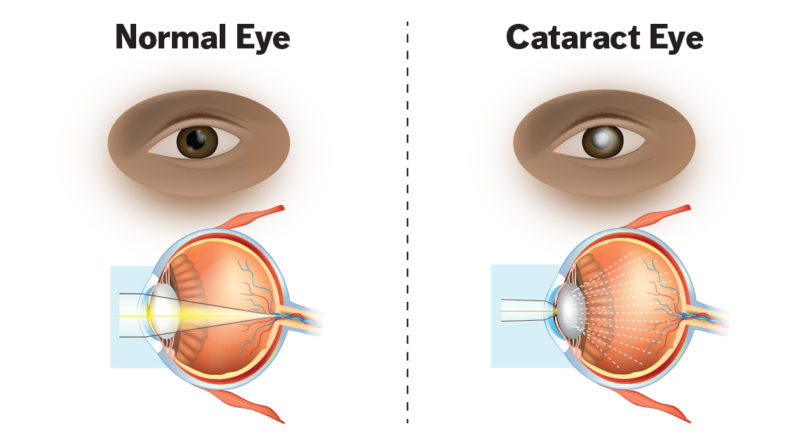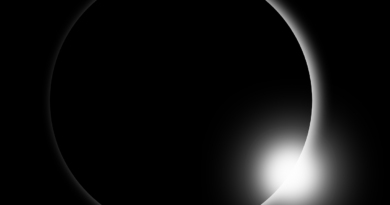Cataract: Causes, Symptoms and Treatment
Cataract is an eye disease that occurs mostly in adulthood or old age, but some examples are found that it occurs in the eyes of young, children and even newborn. Our eye is like a camera with a powerful translucent lens similar to the camera lens. This lens helps in capturing a picture of the outer view on the sensitive layer of the eye, called the retina, from where the visual nerve (eye nerve) is used to convey this view to the brain.
When this transparent lens becomes opaque by losing its transparency due to any reason, it is called cataract. Usually once the process of cataract begins, it cannot be stopped. Just as milk is made into curd, after the process of curd starts, milk cannot remain milk, curd cannot become milk again. Similarly, it stops when cataract begins to form.
When the cataract begins to appear, the eyesight begins to blur, that is, the near and distant scenes begin to appear blurred, then the distant sight starts to weaken gradually. Initially, the use of spectacles makes the things clearly visible, but as the cataract increases, the number of glasses also changes (increases).
There is neither headache nor redness and pain in eyes when cataract starts. Yes, there is a feeling of frequent watering of the eyes and initially, there are complaints of two or more of one appearing.
When the cataract increases, it becomes difficult to get out of the house. After too much time, there is a situation that nothing but light is visible and a temporary blindness becomes. After the operation of cataract, the darkness disappears and the eyesight becomes the same again. There can be other reasons for the loss of eyesight that is not necessarily the reason for the loss of eyesight. Due to cataract, the eyesight starts to decrease, this is true. In this way, the opaque element on the lens causes it to appear less and less – this disease is cataract.
Why does cataract occur and can there be measures to avoid it?
Many people do not have cataract even when they are old and their eyesight becomes weak due to other reasons but most people get cataract when they get old. Aging is one of the reasons for this or due to malnutrition and lack of vitamin ‘A’, protein, vitamin B, C etc. in the diet, using toxic drugs can cause cataract.
Inflammation or bruising in the eyes, bright sun rays, eye diseases such as night blind congenital heat (syphilis) and diabetes (diabetes) can also cause it. The exact reason for this is not yet fully known as to why cataract occurs.
Is there any difference between Cataract and Kanchabind (black cataract)?
There is a huge difference and the sooner this difference is understood, the better. Weakness is not just a cataract. Optic nerve, a defect or glaucoma of the eye-nerve, which you can also call a vision-pulse, can also cause poor eyesight. This condition is called ‘Glaucoma’.
If we examine people above forty years of age, then Glaucoma will usually be found in two percent of these people. It usually happens after the age of 40, but like cataract, it can also happen at a young age due to some reasons. Excess pressure on the eye causes stiffness, which destroys the delicate parts of the eyeball. Due to the delay in getting used to seeing in the dark or dim light, one often stumbles, does not see properly in the evening and night, has a headache, swelling on the eyelids, eyes reddening and pain, head.
Unbearable pain in half and often vomiting, etc., are symptoms that can give rise to glaucoma. Its correct decision and difference can be made only when such symptoms are seen immediately after an eye examination is done by a skilled ophthalmologist. There should be no delay, speculation and carelessness, as it becomes incurable and causes blindness when not cured, before it is too late.
Cataract is treated even if it is delayed by the operation, but in case of glaucoma it becomes impossible to avoid being blinded. Such careless patients reach the doctor late and upon examination, it is found that the sight that has been destroyed due to Glaucoma, which cannot be treated. The rest of the eyes can still be saved.
Please indicate what type of glaucoma is there?
Although there are many types of Glaucoma, but there are two types of symptoms in them. There is a type of vitreous in which symptoms such as acute headache, eye pain, swelling on the eyelids, red eyes ruddy and vomiting due to unbearable pain are found. This, at times, the light of the eyes becomes very less, that is, it becomes blurred and appears blurred. This type of glaucoma is called acute congestive glaucoma.
In the second type of Glaucoma, these symptoms are absent. A slight headache or eye pain, changing the number of reading glasses quickly, difficulty in reaching your seat in the dark in the cinema hall are symptoms. In this case, it takes time to get used to seeing in the dark or in low light and as the disease increases, the visibility of the eye reduces.
What measures can be taken to prevent these diseases so that they do not happen?
To avoid these or at least it does not start early, one must keep our diet in such a way that adequate amount of protein and vitamins, especially vitamin ‘A’ is available. Milk, Cabbage, Papaya, Carrot, Spinach, Mango, Black Pepper, Raw Coconut, Butter, Ghee, Green Vegetable. Amla, etc. should be used from time-to-time. Eyes should be protected from strong sunlight, excess heat, x-rays and injuries. Those who have diabetes or heat (syphilis) disease should be treated promptly, otherwise the operation of cataract will prove to be difficult and cause other problems.
If this disease occurs, what is its treatment?
If there is a decrease in eyesight, then an eye specialist should get an eye examination done to find out which disease is occurring. Many people lose sight due to being late. When it is found out that there is cataract or vitreous or any other disorder, then it can be treated. Some people consider it to be cataract on the advice of the neighbors, and wait for its ripening. In such a situation, if there is a cataract or other related diseases, then delay may prove fatal.
It is not necessary to have an operation when the cataract has occurred, nor is it necessary that the operation be done only in the cold or rainy season. It is advisable to do the operation only in terms of physical comfort and comfort during the cold weather, it is not related to the operation of the rest of the eye. This operation can be done in any season and the truth is that cataracts can be treated not by medicine, but only by operation and the sooner it is done, the better. In contrast, the glass point very quickly destroys the base of the eyes’ power.
Is cataract operation big and difficult?
Absolutely not, a drug is injected into the eye before the operation and the operation is performed later. After following the doctor’s full instruction after the operation and resting for 6-7 days, the patient’s eyes become well as before. Then after one and half months, eyes are again given eyeglasses, and the patient is able to work without facing any vision-related difficulties.




